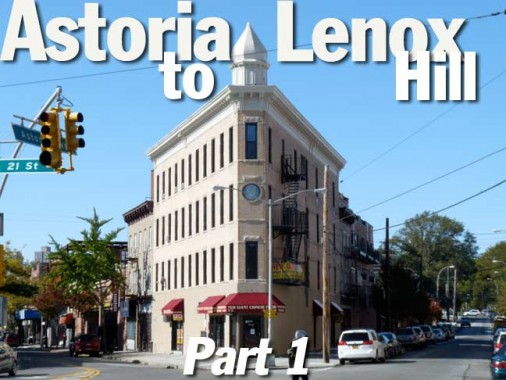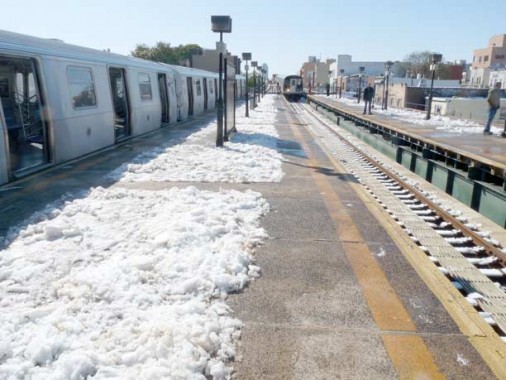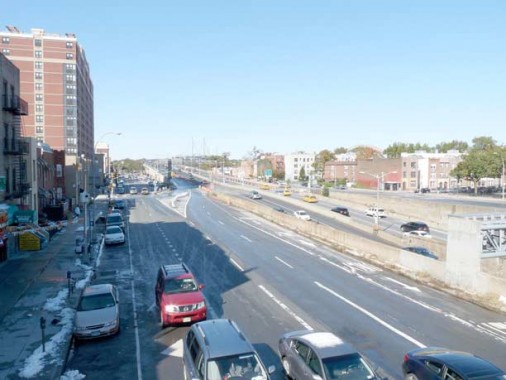I set out to walk from the Astoria Boulevard BMT elevated station to the Mount Vernon “Hotel” in Lenox Hill on October 30, 2011, a bright fall day that was the first day following NY’s heaviest snowstorm of the winter, as it has likely turned out. On October 29th, parts of the city got 6 inches, while other parts got none at all; howls of those expecting a new ice age were heard, but as it turned out it was the mildest winter in years, with 45-50 degrees each day the rule, and only one other measurable snowfall. I am writing this at the end of February, but I’ll be pretty surprised if any blizzards hit in March.
NYC’s deepest snow accumulation of the year on the center platform Astoria Boulevard station, October 30.
Looking northwest from the Astoria Boulevard platform over Grand Central Parkway toward the Triborough, er, Robert F. Kennedy Bridge, which celebrated its 75th anniversary in 2011, as well as ForgottenTour #48.
GOOGLE MAP: ASTORIA TO LENOX HILL
Headed west on Astoria Boulevard. This magazine shop/newsstand had everything in the window, the porn rags mixed in with the legit mags. It’s all entertainment, no?
This 2-story building at 27th Street probably goes back to the very early 1900s. The sign on the right advertises the Messinian Benevolent Association and Aristomenis Inc., and as you’d expect in Astoria, it’s a Greek organization, Messinia, or Messenia, being a region in southwest Greece and Aristomenis a village within.
There are some buildings that pretty much leave no question as to their purpose, and Astoria World Manor is indeed a catering hall. TV shows filmed in the NYC area such as The Sopranos, Gossip Girl and Ugly Betty have filmed interiors here. The hall opened in the 1950s as the Astorian and after the original owner passed away in 1984 it fell on hard times, but was rechristened Astoria World Manor in 2005.
At Crescent Street (which takes the place of 25th for most of its route) is the imposing Mt. Carmel School, which is associated with Our Lady of Mount Carmel Church (seen behind the stoplight at left).
Unlike many churches, OLMC doesn’t stint on parish history and neighborhood history on its website:
On July 3, 1841, the trustees secured property at Trowbridge Street (26thAve) and Van Alst Ave (21st Street) to build the church. The two plots of land on which the church was built came from John Shea, a New York teacher, and his wife, Mary Ann. This lot was secured for $1.00. The first mass in this first parish church was said in September 1841. Subsequent land donations came from Mr. Andersen, a prominent Episcopalian, who donated a half lot. Another half lot which was used for the cemetery was secured from the Riker family. This small cemetery is still in existence. Stephen Halsey donated the stone for the foundation of the church building…[the present church was consecrated in 1873]
Our Lady of Mount Carmel was the first Catholic community in Queens County to have a resident priest, and the first to conduct Mass in its own church building. Furthermore, it was the base of operations for the heroic Father Michael Curran who fanned out from Astoria regularly to be the first priest to celebrate Mass at numerous localities that eventually became parishes throughout Queens (which included today’s Nassau County until 1898) and even throughout Suffolk. Thus while not technically by some definitions the oldest parish in Queens, it certainly merits the title “Mother Church of Queens County”. OLMC
OLMC owns and cares for the Irish Famine Cemetery in Astoria Village (see below) at 21st Street and 26th Avenue.
What is likely the parish house or rectory is adjacent to the school on Astoria Boulevard.
Millionaire Realty uses a classic awning sign with an old alphanumeric phone number (AS for Astoria) and a large R, likely for Realty, on the side of the rolldown gate.
Several roads converge at Astoria Square: Astoria Boulevard, 21st Street (formerly Van Alst Avenue), 27th Avenue (formerly Franklin Street). Today’s Astoria Boulevard was created in the 1920s and is an amalgamation of two routes: in Astoria Village, Main Street; east of 21st Street, it was known as Flushing Avenue, for the town it pointed towards. Before Queens’ street naming system was instituted in the 1920s there were several sets of numbered streets, as well as several streets with the same name, such as Flushing Avenue — there were two in Maspeth and one in Astoria, and likely a couple more.
I haven’t been able to find out much about the nearly triangle-shaped building in the fork formed by Astoria Boulevard and 27th Avenue, but it’s been handsomely restored in recent years and its decorative cornice has miraculously survived the decades.
Where there is the sublime you usually find a doubled amount of ridiculous. This people storage unit stands across 27th Avenue from the triangle building.
One final reminder remains of Fishbein’s, a former department store at Astoria Boulevard and 27th Avenue.
Astoria Village
What is presently called Astoria Village is a cluster of narrow streets between the East River and 21st Street north of Astoria Boulevard in Hallet’s Cove, and indent of the East River just south of Hell Gate. In 1652, settler William Hallet received a land grant here from New Netherland Director General Peter Stuyvesant. Nothing remains of Hallet’s settlement, but many buildings that were built following the early-19th Century development of the area by fur merchant Stephen Ailing Halsey do, including some formerly magnificent mansions overlooking the river built by shipping and lumber company magnates. Ailing dubbed the area, after a lengthy and argumentative struggle among the locals, in tribute to fur magnate John Jacob Astor, who was amused by the honorific but never deigned to cross the river to visit.
Astoria Village was never landmarked as a neighborhood, and so its historic aura has been disappearing piece by piece, especially from the 1990s forward. Even neighborhood residents have been complicit in this deterioration, as they fear the potential sale value of their properties will be reduced by preservation.
The above map shows Astoria Village in 1840. The streets shown are still there and have been augmented by others. Franklin Street was extended through Owen and 1st Streets and is today’s 27th Avenue, while Main Street is Astoria Boulevard for much of its route. Second and Third Streets are now 12th and 14th Streets (lucky 13 was skipped in the renumbering project in Astoria Village though it does appear in Ravenswood to the south).
Astoria Village’s handsome library building at Astoria Blvd. and 14th Street was constructed after a generous grant from industrialist/philanthropist Andrew Carnegie and was finished by 1904. Carnegie’s largesse allowed 1689 libraries to be built across the USA.
The Astor Bake Shop, a pleasant breakfast/lunch place, occupies the ground floor of a multifamily building at Astoria Boulevard and 14th Street. The yelp.com reviews are mostly favorable.
Both 12th and 14th Streets feature rows of attached homes like this that are reminiscent of similar ones further east in northern Woodside. Unlike modern Fedders Specials, they were designed with some aesthetics in mind and each has a patch of green in front, variegated brickwork, and different roof treatments. The rise of the auto, which came later, prompted developers to place black holes in front of buildings like this in the form of garages and ramps.
St. George Church
There has been a St. George Episcopal parish in Astoria since 1825 when its site was donated by landowner Robert Blackwell; its original church, constructed 1827 was on Franklin Street, today’s 27th Avenue. After that edifice burned down in 1894, the present, fantastically gargoyled brick church at 27th Avenue and 14th Street was raised in 1903-1904. The Astoria Library (see below) stands on the site of the present church.
Citing financial straits, the church was leased to a developer in 2005, which promptly razed its parish house, the old Astoria Institute for the Education of Young Ladies (top), and soon after built a block of Fedders residences, in this case, Friedrich, seen below.
St. George Cemetery
At present the St. George churchyard is attainable only by an unmarked driveway on 27th Avenue. The historic cemetery contains remains of early settlers in the area, the Blackwells and Trowbridges.
Two of 14th Street’s remaining cottage-like houses, and the for-sale sign that has gone up in front of one. Will the buyer maintain the house, or tear it down and build multifamily units, as has happened elsewhere in Astoria Village?
On occasion larger homes on wider plots can be found in Astoria Village, such as the former Trowbridge mansion at 26th Avenue and 14th Street. The Trowbridges had a number of houses in Astoria Village.
Rosemont
What was once known as Rosemont, a mansion on 25-37 14th Street, has been pretty much buried by now under aluminum siding, but it used to be a beautiful two-level Doric-columned country house.
In 1852 the mansion was built in a grand Southern-plantation style by varnish moguls Smith & Stratton, who operated in Astoria Village till 1856; they then decamped further down the east Riverside to Hunter’s Point. In the 1990s, it was converted to the wreck you see today at 25-37 14th Street, “raped and ravaged” in the words of the AIA Guide to NYC. Its ancient copper beech tree has long been chopped down, and the exterior has been converted to something considered more appropriate to the times by its current owner, or at least a recent one. (I don’t know the derivation of the current name, “Bilquis Mansion.”)
“The Benner Mansion, occupied for many years by the late Robert Benner, a prominent New York lawyer, is another superb place. Mr. Benner was an enthusiast in floriculture and arboriculture. The beautiful gardens contain many specimens of rare trees and shrubs while the flower beds, chrysanthemums and rose houses have wide renown. The cultivation of these flowers was Mr. Benner’s delight and he added many new specimens by propagation and cultivation to the world’s knowledge. He named his house “Rosemont!” and the name was appropriate. Mrs. Benner resides in the old home, and as her love for flowers equals that of her late husband, the place is still superbly kept up. Mr. Benner’s sons, Willis and Charles, are the law firm of Benner & Benner of Wall St. They both live in Astoria, the former in the old homestead and Charles in the former house of the late Joshua Lathrop, the old New York flour merchant.” – New York Times, July 12, 1896
Moving over to 12th Street, the construction of this hi-rise along the route of Shore Boulevard about 40 years ago began to change the culture of the street, which was formerly lined with pleasant country homes–many of which have been replaced.
One of 12th Street’s remaining country homes at 26-07, “Tara,” the Craig-Baylies house (once owned by physician and Blackwell heir Dr. H. Baylies) was recently restored to its late 19th Century grandeur.
A selection of the dwindling 19th-Century dwellings found on Astoria Village’s 12th Street.
The Robert Blackwell house, now the Greek Orthodox Church of the Holy Protection of the Mother of God, was constructed at the NE corner of 12th Street and 27th Avenue in the 1840s. It has a beautifully lettered sign featuring both Greek and Roman lettering (in English).
The Intercession of the Theotokos or the Protection of Our Most Holy Lady Theotokos and Ever-Virgin Mary, known in Church Slavonic as Pokrova (Покровъ, “protection”), and in Greek as Sképē (Σκέπη), is a feast of the Mother of God celebrated in the Eastern Orthodox and Byzantine Catholic Churches. The feast celebrates the protection afforded the faithful through theintercessions of the Theotokos (Virgin Mary). In Russia it is celebrated as the most important solemnity after the Twelve Great Feasts. The feast is commemorated in Eastern Orthodoxy as a whole, but by no means as fervently as it is in Russia and Ukraine. wikipedia
The venerable brick building on the NW corner of 12th and 27th Avenue is the Chamberlain-Taylor (deWayt) house, constructed in 1845.
The building next door is likely of comparable age but has been compromised by panels of siding.
Astoria Village’s Catholic church, St. Margaret Mary, was completed in 1968 and features decorative mosaic panelling. Unlike Our Lady of Mount Carmel Church, there are slim pickings online about the church’s history.
The church’s namesake is Ste. Marguerite Marie Alacoque (1647-1690)
She was born at Lhautecour, a village in the diocese of Autun, now part of the commune of Verosvres in 1647. From early childhood, Margaret was described as showing intense love for the Blessed Sacrament (the Eucharist), and as preferring silence and prayer to childhood play. After her First Communion at the age of nine, she practiced in secret severe corporal mortification until rheumatic fever confined her to bed for four years. At the end of this period, having made a vow to the Blessed Virgin to consecrate herself to religious life, she was instantly restored to perfect health. wikipedia
The phrase ‘severe corporal mortification’ brings to mind the somewhat barbaric, in my opinion, practices of the old Church:
From the prophets of the Old Testament, who frequently fasted and wore sackcloth (also known as a hair shirt; an undergarment made of rough material such as goat hair), to the Apostles who imposed severe fasts on their bodies, to the saints and religious orders throughout Church history, penance has been a common practice in the Christian life. Saint Francis De Sales for example, was known to use the discipline (self-flagellation, using a whip, rod, or lash), as well as an iron belt and hair-shirts. Saint John Marie Vianney was known for his austerities in fasting, as well as frequent use of the discipline. Saint Jose Maria Escriva often wore a cilice (a band of chain links with small prongs, typically worn around the upper thigh). Other Saints who were known to use exterior mortifications include; Saint Veronica Giuliani, Saint Margaret Mary Alacoque, Mother Teresa, Saint Dominic, Saint Louis De Montfort, Padre Pio, Saint Maximilian Kolbe, and many others. The list is simply too long to detail here. Such practices were also common-place among many religious orders throughout history until the mid-twentieth century, and was even practiced by many lay people living in the world. Religious Vocation
Religious practice, and the sometime self-abuse used to reinforce faith, is far afield from the purview of Forgotten New York, however.
First Reformed Church
One more church to see on this walk, The Reformed Dutch Church of Hallets Cove (now Good Church of Deliverance) at 27-26 12th (left) was built in 1888; its verdigris’ed steeple replaced the original in 1900. The parsonage, which may date as early as the 1850s, is just to its south. A line drawing of the church and a brief description can be found in the NY Times 7/12/1896 article.
Now for something completely different: one of the many murals found on 30th Avenue and Welling Court west of 12th Street. FNY has a fairly comprehensive view of them on this page.
I have always been intrigued by the multicolored plastic-lettered Horstmann Mix & Cream sign on 12th south of 30th Avenue. As far as I can gather it is, or was, a dry, condensed, and evaporated dairy product manufacturing firm.
South of Astoria Boulevard we encroach upon the Ravenswoood region, which has its own set of intriguing older buildings, such as these along 30th Road between 12th and Vernon.
Like most of New York City’s other neighborhoods, Ravenswood was first settled by the Dutch when Captain Francis Fyn acquired what would later be called Roosevelt Island and the strip of land facing it across the East River on Long Island in 1651. That island’s namesake for decades was Robert Blackwell; his mansion on Blackwell’s, now Roosevelt, Island still stands, and his son, Jacob, built an imposing dwelling on the East River at about today’s 37th Avenue in 1744 that was razed in 1901.
A group of impressive mansions was arrayed on Vernon Boulevard (neé Avenue) in the mid-1800s, none of which remain today. The area came into its own as a residential area in the 19th century but only after NYC had bought up land in the 1840s and proceeded to build orphan asylums and smallpox hospitals. In 1845, angry Astorians burnt the smallpox hospital to the ground, and the asylums found a home on Blackwell’s Island. [For the rest of the story, see the above link]
Name that car: I know the blue truck is a Chevy, but that’s all I know.
From Vernon Boulevard, there’s an occasional view of the East River, Manhattan Island and Roosevelt Island. Although this is officially Socrates Sculpture Park Beach at Hallet’s Cove, swimming is prohibited in the roaring Hell’s Gate current. This is, though, a kayak launch point in season.
2/26/12



